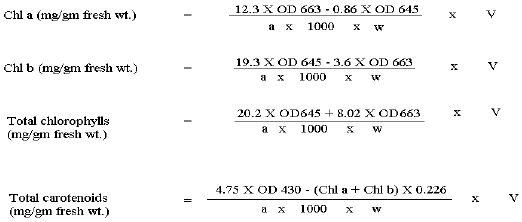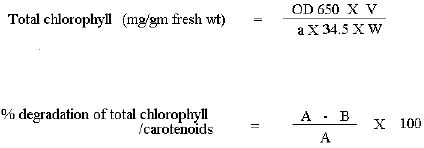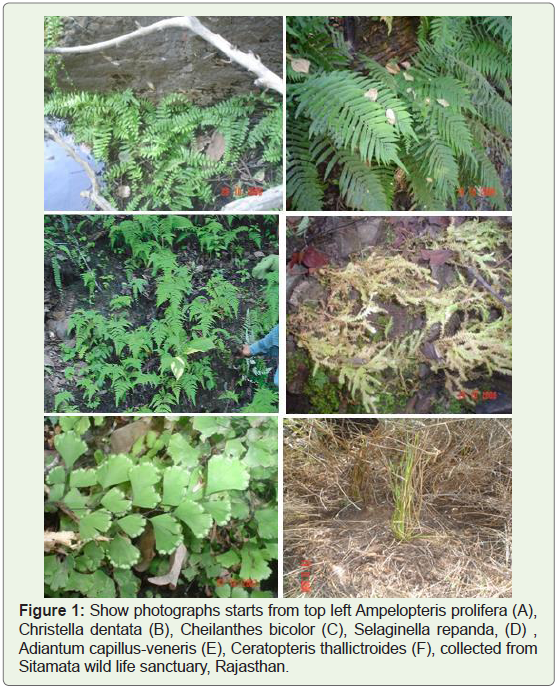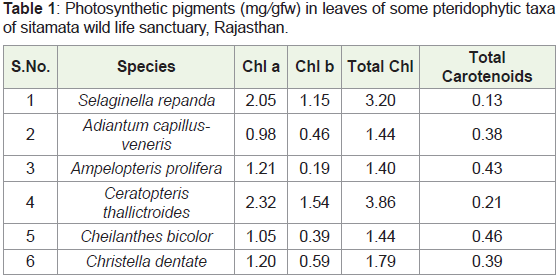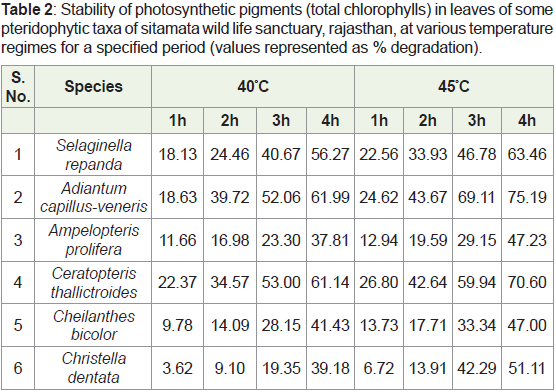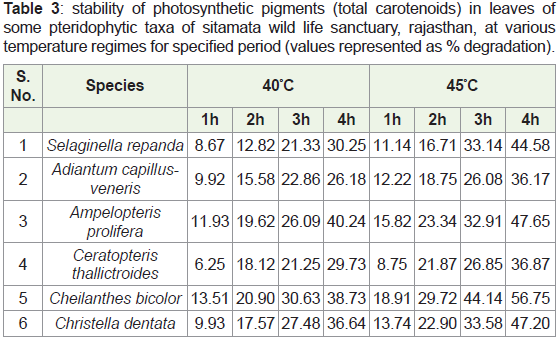Research Article
Effect of Hyperthermia on Photosynthetic Pigments of Some Selected Fern Taxa of Sitamata Wild Life Sanctuary, Rajasthan
Sharma V*
Department of Botany, Acharya Shri Mahapragya Institute of Excellence, Asind, Bhilwara (Raj), India
*Corresponding author: Sharma V, Department of Botany, Acharya Shri Mahapragya Institute of Excellence, Asind,
Bhilwara (Raj), India; E-mail: vinaysharma337@gmail.com
Copyright: © Sharma V. 2022. This is an open access article distributed under the Creative Commons Attribution License, which
permits unrestricted use, distribution, and reproduction in any medium, provided the original work is properly cited.
Article Information: Submission: 23/08/2022; Accepted: 04/11/2022; Published: 07/11/2022
Abstract
Rajasthan, the state is situated in the north western part of India and covers as area of 3, 42, 274 sq.km. Despite the hostile climatic conditions of the
state, pteridophytes which otherwise known as shade and moisture loving plants. Sitamata wild life sanctuary is located at southwest region of Rajasthan.
Different species of pteridophytes in this region exhibit significant variation in thermal stability of their photosynthetic pigments Studies reveal that total
chlorophyll contents are maximum in Ceratopteris thallictroides and Selaginella repanda and minimum in Ampelopteris prolifera. The other species range
between these two. Total carotenoid contents were found maximum in Cheilanthes bicolor and minimum in Selaginella repanda. These observations suggest
that species with greater resistance to drought possess higher quantity of carotenoids and show lesser degradation in their chlorophyll pigments during
stress conditions. Thus, Ampelopteris prolifera, Cheilanthes bicolor and Christella dentata are most resistant to heat and drought conditions while A. capillusveneris,
Ceratopteris thallictroides and Selaginella repanda are the least resistant taxa to heat and drought conditions.
Keywords
Thermal stability; photosynthetic pigments; Carotenoids, Chlorophyll content
Introduction
The dry and hot climate of Rajasthan display abundant growth of
pteridophytes from end of July to mid October after which these start
to dry up, the photographs of selected fern taxa were shown in Figure 1. Sharma et al. (1977) have established the importance of chlorophyll
stability index as an important factor for heat and drought resistance
in plants [1]. A higher chlorophyll stability index indicates higher
capacity for heat and drought resistance. Studies on photosynthetic
pigments shows that total chlorophyll contents are maximum in
Ceratopteris thallictroides and Selaginella repanda and minimum in
Ampelopteris prolifera. The other species range between these two.
Total carotenoid contents were maximum in Cheilanthes bicolor and
minimum in Selaginella repanda. These observations support the
findings of Rathode and Sharma (1991) who concluded that aquatic
and shade loving plants have more amounts of chlorophylls and less of carotenoids while reverse are true in drought resistant types
[2]. Analysis of photosynthetic pigments in some pteridophytes was
studied in ratnagiri district of Maharashtra suggested that changes
were found in amount of chlorophyll pigments during formation of
sporangia [3]. Some Physiological studies including photosynthetic
pigments like total chlorophylls, carotenoids, polyphenol, major
organic and inorganic constituents of pteridophytic flora of Lohgad
area of Maharashtra was studied by Gavade et al, ( 2015 ) [4]. The
effect of arsenic (As) on photosynthesis of Pteris cretica studied
by Zamanova et al, (2021) who reported that increasing doses of
Arsenic decreases of net photosynthesis, Transpiration rate and
photosynthetic pigments [5].
Materials & Methods
1gm of fresh leaves of mature plants was homogenized in 15 ml of 80% acetone. After centrifugation, the supernatant was used
for quantitative analysis of photosynthetic pigments.Quantitative
estimation of chlorophyll a, chl.b, total chlorophylls and total
carotenoids was done following the method suggested by Robbelen
(1957). Optical densities were recorded at 663 and 645 nm for
chlorophylls and at 430 nm for total carotenoid content using a
Systronics Spectrophotometer 106 [6]. The Amount of chlorophylls
and carotenoids were calculated as per the following formulae:
V = Volume of solvent (Acetone) in which the Fresh material was
crushed.
a = Length of light path in the cell which is usually 1
cm.
W = Fresh weight of material in gms. This was
crushed.
To determine heat and drought resistance of the selected taxa,
thermal treatments of 40°C and 45°C were given to 1 gm fresh leaves
in 20 ml distilled water in a water bath for 1h, 2h, 3h and 4h time
duration along with controls at room temperature [7]. The leaves
were then homogenized in 10 ml of 80% Acetone. Optical densities
were recorded at 650 nm and 430 nm respectively.
Total chlorophyll contents and percentage degradation of total
chlorophylls and carotenoids were calculated as per the following
formulae:
A study of chlorophyll a, chlorophyll b, total chlorophyll and
total carotenoids in leaves of mature plants of selected species of
pteridophytes occurring in Sitamata wild life sanctuary, Rajasthan
has been carried out. Photographs and Data have been presented and
Text Figure 1 and in Table 1, respectively.
Figure 1: Show photographs starts from top left Ampelopteris prolifera (A),
Christella dentata (B), Cheilanthes bicolor (C), Selaginella repanda, (D) ,
Adiantum capillus-veneris (E), Ceratopteris thallictroides (F), collected from
Sitamata wild life sanctuary, Rajasthan.
Results
Treatment of 1-4 hours at 40ºC lead to higher total chlorophyll
content degradation in Ceratopteris thallictroides followed by A. capillus-veneris and Selaginella repanda while in Christella dentata,
Cheilanthes bicolor and Ampelopteris prolifera it was comparatively
low. A temperature treatment of 45ºC for 1-4 hours lead to further
loss of total chlorophyll content which was comparatively more in
A. capillus-veneris, Ceratopteris thallictroides and Selaginella repanda.
These species thus, show more thermal decay in total chlorophyll
content compared to Ampelopteris prolifera, Christella dentata and
Cheilanthes bicolor.
Ampelopteris prolifera, Cheilanthes bicolor and Christella
dentata show maximum degradation of total carotenoids after
4 hours treatment at 45ºC. This percentage of total carotenoid
content degradation was recorded to be minimum in Adiantum
capillus-veneris, Ceratopteris thallictroides, Ampelopteris prolifera and Selaginella repanda. Maximum percentage of total carotenoid
degradation at 40ºC was observed in Cheilanthes bicolor, Ampelopteris
prolifera and Christella dentata and it was to be minimum in
Adiantum capillus-veneris, Ceratopteris thallictroides, and Selaginella
repanda.
Conclusion
Inverse relationship in the degradation pattern of the two
different types of photosynthetic pigments namely chlorophylls and
carotenoides at higher temperatures is evident in ferns and fern allies
of Sitamata forest of Rajasthan. Thermal decay in photosynthetic
pigments is a limiting factor for plant growth and supra optimal
conditions [8-9]. Bohra et al. (1980) and Yadav & Bhardwaja (1983)
concluded that xerophytic species of ferns possess higher carotenoid
contents and show lesser degradation of chlorophylls [10-11]. This
fits in well with the known functions of the carotenoids-protection of
plants from photosensitised oxidation of chlorophyll pigments [12].
The highest chlorophylls were found in gametophyte of Adiantum
flabellatum and the highest carotenoids were obtained from the
gametophyte of Cheilanthus albomarginata [13]. Distribution and
phytochemical studies of some pteridophytes from northern India
and Rajasthan state were carried out suggested that species with
greater resistance to drought possess higher quantity of carotenoids
and show lesser degradation in their chlorophyll pigments during
stress conditions [14-15]. Similar observations have been made
by Kothari and Yadav (2003). Pareek et al. (2005) and Tripathi et
al. (2005) on some ferns and fern allies of Rajasthan [16-18]. Thus,
Ampelopteris prolifera, Cheilanthes bicolor and Christella dentata with higher degradation in carotenoids and greater stability in chlorophyll
pigments are most resistant to heat and drought conditions while A.
capillus-veneris, Ceratopteris thallictroides and Selaginella repanda
with higher degradation in chlorophyll pigments are the least resistant
taxa to heat and drought conditions.
Total chlorophyll contents among ferns and fern allies were
found to be highest in Ceratopteris thallictroides (3.86mg/gfw) and
lowest in Ampelopteris prolifera (1.40 mg/gfw). Highest amount
of total carotenoids has been observed in Cheilanthes bicolor (0.46
mg/gfw) and lowest in Selaginella repanda (0.13 mg/gfw). These
observations suggest that species with greater resistance to drought
possess higher quantity of carotenoids. Thus, Cheilanthes bicolor and
A. prolifera, which withstand the unfavorable conditions for longer
period, contain higher quantity of carotenoids.
Discussion
Among various metabolic changes underlying the mechanism of
heat and drought tolerance of these taxa, mention may now be made
of the effect of hyperthermia on total chlorophylls and carotenoids.
The data have been presented in Table 2-3. A perusal of Table 2
reveals that different species exhibit significant variations in thermal
stability of their photosynthetic pigments. Thus, an hour’s treatment
at 40°C led to maximum chlorophyll degradation in Ceratopteris
thallictroides (22.37%) followed by A. capillus-veneris with (18.63%),
S. repanda (18.13%) and Cheilanthes bicolor it was (9.78%) while
the minimum chlorophyll degradation was recorded in Christella
dentata (3.62%). However, 4 hour’s treatment at 40°C showed highest
degradation of total chlorophyll contents in Adiantum capillusveneris
(61.99%) and Ceratopteris thallictroides (61.14%) and the
lowest in Ampelopteris prolifera (37.81%). Other species are ranging
between these two. A temperature treatment of 45°C for four hours led
to further loss of total chlorophyll content which was comparatively
more in Adiantum capillus-veneris (75.19%) and Ceratopteris
thallictroides (70.60 %). These two texa show more thermal decay in
total chlorophyll contents compared to Cheilanthes bicolor (47.00%),
Ampelopteris prolifera (47.23%) and Christella dentata (51.11%). Data
pertaining to carotenoid contents in response to specified periods of
temperature treatment are presented in Table 3. It may be observed
from these data that Cheilanthes bicolor (13.51%), Ampelopteris
prolifera (11.93%), Christella dentata (9.93%) and Adiantum capillusveneris
(9.92%) show higher degradation in carotenoid contents after
1-hour treatment at 40ºC. This percentage of total carotenoid content
degradation was recorded to be lower in species of Ceratopteris and
Selaginella. Almost similar pattern of carotenoid degradation has
been observed at different time duration at 40ºC and 45ºC temperature
treatment.
Table 2: Stability of photosynthetic pigments (total chlorophylls) in leaves of some
pteridophytic taxa of sitamata wild life sanctuary, rajasthan, at various temperature
regimes for a specified period (values represented as % degradation).
Acknowledgement
Author is thankful to Dr. B. L.Yadav for his guidance and moral
support. I also appreciate Botany department of MLV Govt. College,
Bhilwara for providing infrastructure and research facilities.

